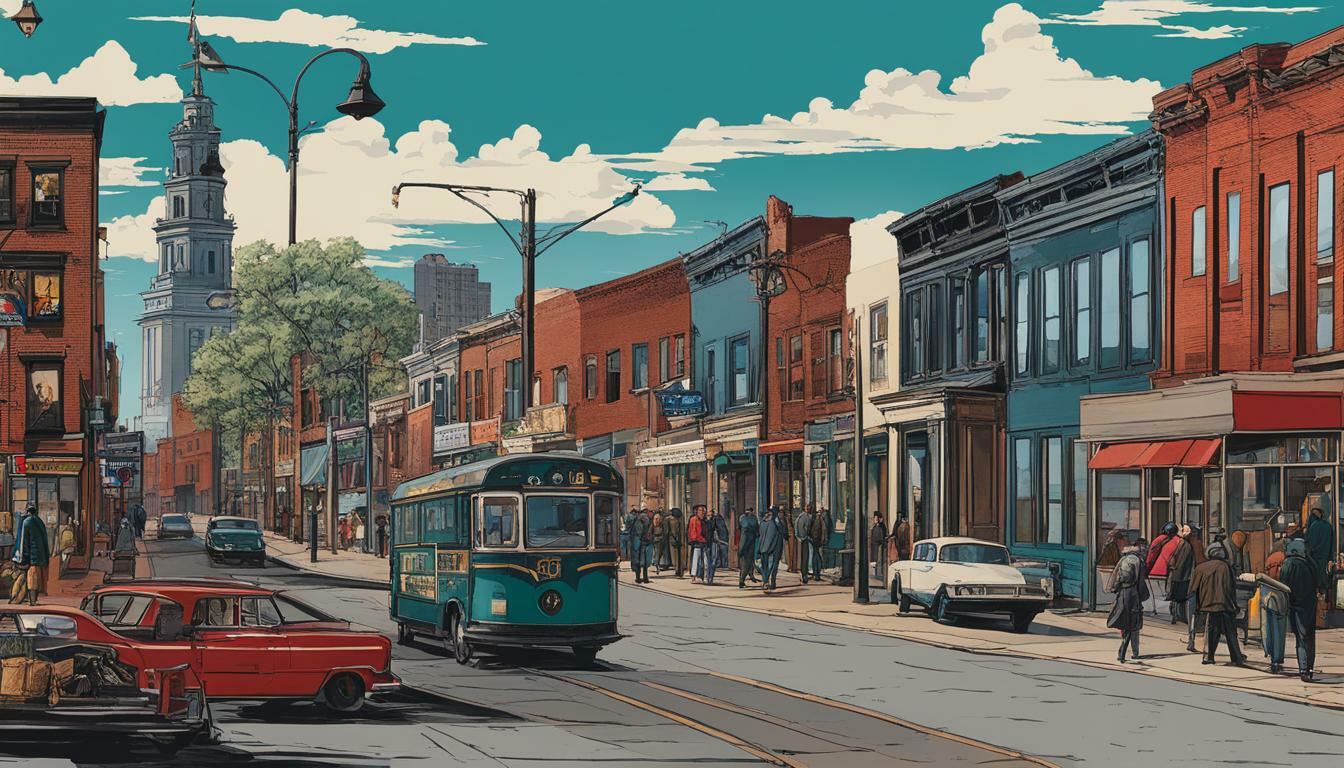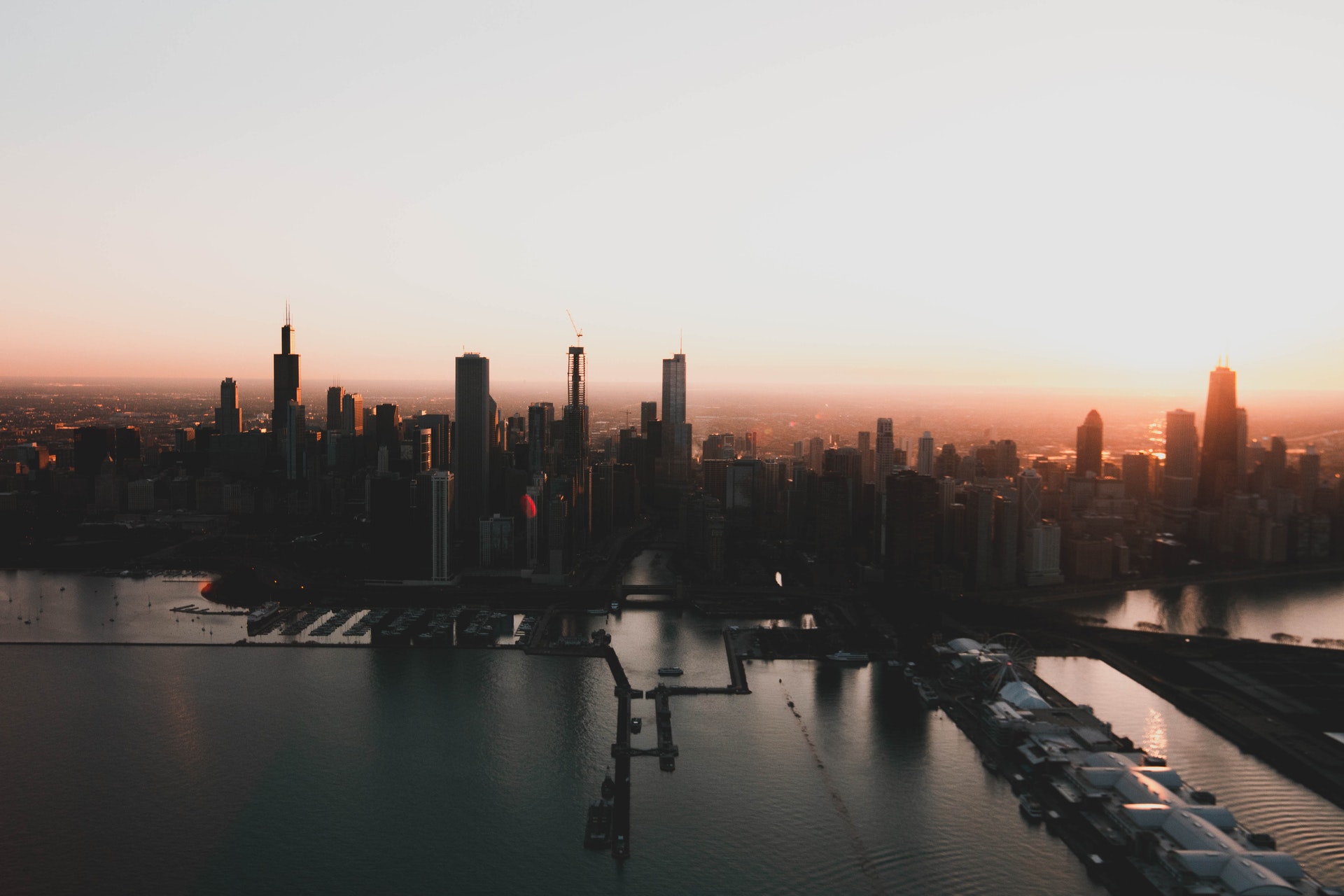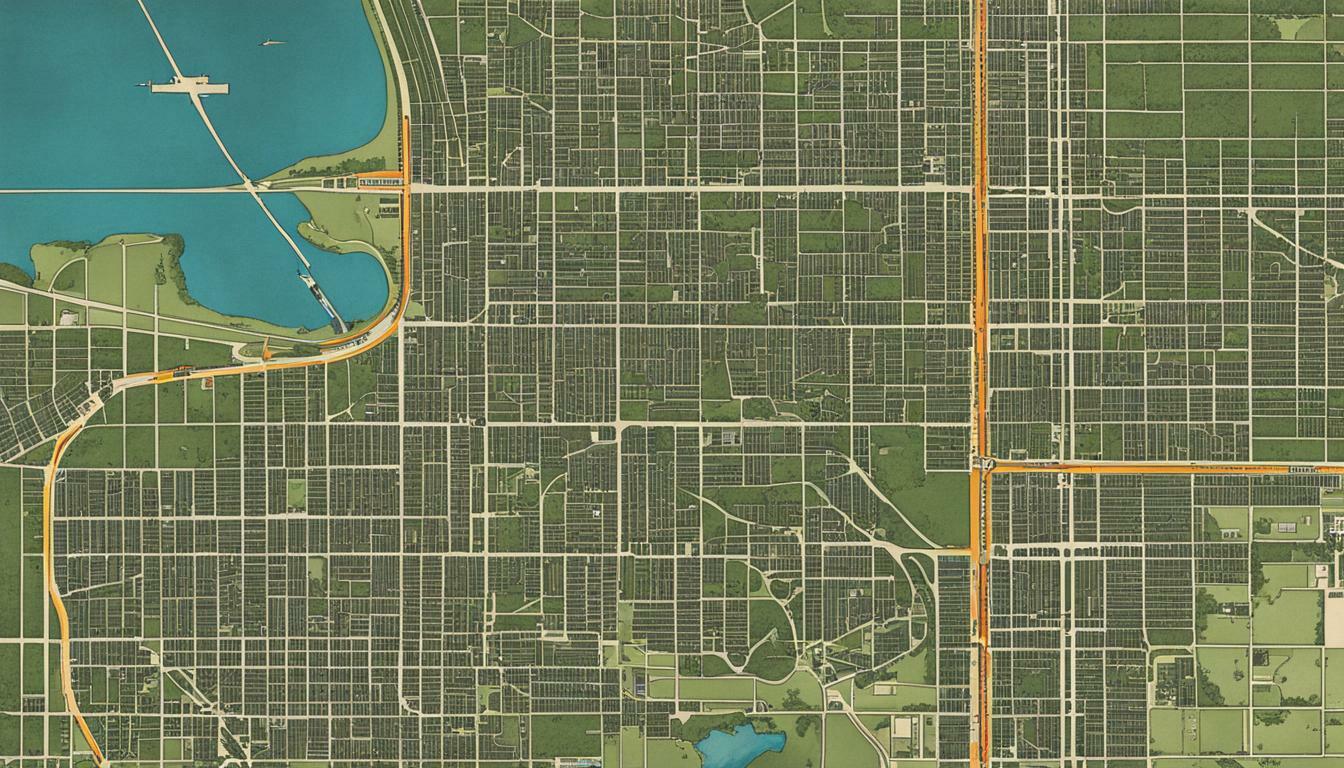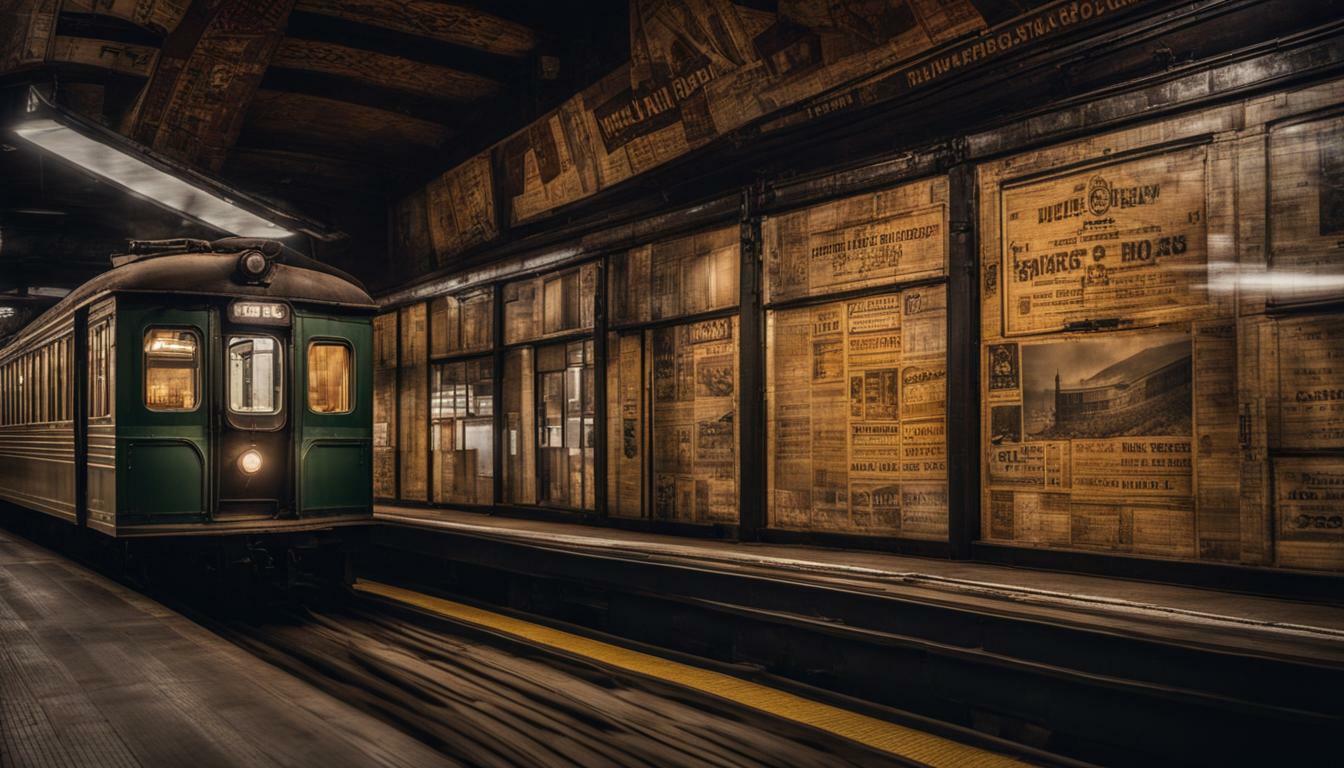Humboldt Park, located on the Northwest side of Chicago, has a fascinating history that encompasses cultural diversity, immigration, and community preservation. Named after Alexander von Humboldt, the neighborhood became part of Chicago in 1869 and has since been a melting pot of different ethnic groups. Over the years, the park itself has served as a symbol of cultural preservation, with statues representing various ethnic groups. The neighborhood has seen waves of immigration, particularly from Europe, shaping its vibrant cultural tapestry. In the 1950s and 1960s, Humboldt Park experienced a significant demographic shift with the arrival of a large number of Puerto Ricans. Today, the neighborhood is known for its strong Puerto Rican community, cultural events, and social justice activism. Despite facing the challenges of gentrification, Humboldt Park continues to embrace its cultural identity and engage the community in preserving its rich heritage.
Key Takeaways:
- Humboldt Park has a rich cultural history, shaped by waves of immigration and diverse ethnic groups.
- The park itself is a symbol of cultural preservation, with statues representing various ethnic groups.
- The neighborhood experienced a significant demographic shift with the arrival of Puerto Ricans in the 1950s and 1960s.
- Humboldt Park has a history of social justice activism and is known for its vibrant cultural events.
- The neighborhood faces the challenge of gentrification but has efforts in place to preserve its cultural identity and engage the community.
The Early Years and Cultural Preservation
Humboldt Park, named after Alexander von Humboldt, has a rich cultural heritage that is evident in its statues and historic landmarks. Established in 1869, this neighborhood on the Northwest side of Chicago has played a significant role in preserving cultural heritage throughout its history. With its diverse population and the waves of European immigration it witnessed, Humboldt Park became a melting pot of different ethnic groups.
The park itself became a symbol of cultural preservation, adorned with statues representing various ethnic groups that make up the neighborhood’s identity. These historic landmarks serve as reminders of the early years of Humboldt Park and the importance of preserving its diverse heritage. Each statue tells a story of the cultural contributions made by different communities throughout the years.
One such notable statue is the Humboldt Park eagle monument, which pays homage to the Polish community that played a crucial role in shaping the neighborhood. This cultural significance is an integral part of Humboldt Park’s identity and attracts visitors, historians, and locals alike who are keen to explore the history and heritage of the area.
| Statue | Cultural Group | Significance |
|---|---|---|
| The Humboldt Park eagle monument | Polish community | Symbolizes the cultural contributions of the Polish community to Humboldt Park. |
| The Simón Bolívar monument | Venezuelan community | Represents the neighborhood’s connection to Latin American culture and the fight for independence. |
| The Garibaldi monument | Italian community | Commends the Italian community’s contributions to the neighborhood and their fight for freedom. |
These historic statues and landmarks in Humboldt Park provide a tangible link to the past, reflecting the early years of the neighborhood and the preservation of its cultural identity. They serve as a testament to the community’s dedication to maintaining its diverse heritage and attracting visitors who are eager to explore the rich cultural history of Humboldt Park.
Waves of Immigration and Demographic Shifts
Throughout its history, Humboldt Park has experienced waves of immigration that have left an indelible mark on its community and demographics. As European immigrants flocked to Chicago in the late 19th and early 20th centuries, Humboldt Park became a magnet for individuals from various countries seeking a new start. The neighborhood welcomed immigrants from Germany, Poland, Italy, and other European nations, each bringing their own customs, traditions, and languages.
This wave of immigration not only added to the cultural tapestry of Humboldt Park but also shaped its distinctive identity. European churches, restaurants, and businesses proliferated, giving the neighborhood a unique character that still resonates today. The statues in Humboldt Park, representing different ethnic groups, stand as a testament to the neighborhood’s commitment to preserving its diverse heritage.
The European Countries That Shaped Humboldt Park
| Country | No. of Immigrants |
|---|---|
| Germany | 10,000+ |
| Poland | 7,000+ |
| Italy | 5,000+ |
| Sweden | 3,000+ |
| Ireland | 2,000+ |
In the mid-20th century, another significant demographic shift occurred in Humboldt Park with the arrival of Puerto Ricans. Seeking economic opportunities and fleeing political unrest, many Puerto Ricans settled in the neighborhood and left an indelible mark on its cultural fabric. The Puerto Rican community in Humboldt Park has since grown and flourished, becoming an integral part of the neighborhood’s identity and contributing to its vibrant atmosphere.
Today, Humboldt Park continues to be a diverse community, shaped by the waves of immigration and the rich cultural heritage of its residents. It stands as a testament to the power of embracing diversity, fostering community engagement, and preserving a vibrant cultural identity.
Social Justice Activism and Cultural Events
Humboldt Park has a rich history of social justice activism, with protests and riots during the 1960s, as well as a thriving cultural scene celebrated by the community and tourists alike. The neighborhood’s legacy of activism is rooted in its diverse population and the desire for equality and justice. During the 1960s, Humboldt Park became a center for civil rights protests, as the community fought against discriminatory practices and advocated for change.
The Humboldt Park historical society plays a significant role in preserving this history and promoting community engagement. The society works tirelessly to document and educate others about the social justice movements that have shaped the neighborhood. Through exhibits, educational programs, and community events, the historical society strives to create a greater understanding of the struggles and victories that have shaped Humboldt Park’s identity.
The cultural events in Humboldt Park are a testament to the community’s rich heritage. Festivals, parades, and performances showcase the diverse traditions and artistic expressions of the neighborhood. These events not only celebrate the vibrant Puerto Rican culture but also provide a platform for other ethnic groups to share their customs and celebrate diversity. Cultural events are an integral part of the neighborhood’s identity and serve as a reminder of the resilience and strength of its residents.
| Humboldt Park Historical Society | Humboldt Park Tourism |
|---|---|
| The Humboldt Park historical society plays a vital role in preserving the neighborhood’s rich history of social justice activism. | Humboldt Park is a popular destination for tourists, drawn in by its vibrant cultural events and attractions. |
| The society documents the struggles and triumphs of the community, ensuring that future generations understand and learn from the past. | Visitors can explore the Humboldt Park Boathouse, enjoy local cuisine in the neighborhood’s restaurants, and immerse themselves in the vibrant Paseo Boricua cultural corridor. |
| The Humboldt Park historical society encourages community engagement through educational programs and exhibits that shed light on the neighborhood’s activism. | Furthermore, the National Museum of Puerto Rican Arts and Culture offers a unique insight into the Puerto Rican heritage and its impact on the community. |
Preserving History, Inspiring Change
The social justice activism and cultural events in Humboldt Park are not only celebrations of the past and present but also catalysts for change. By learning from the struggles of the past and embracing the diverse cultural fabric of the neighborhood, the community continues to fight for social justice and advocate for a better future. Humboldt Park is a place where history is cherished, activism is valued, and cultural identity is proudly preserved.
The Ongoing Fight for Cultural Identity
Amidst ongoing gentrification, residents of Humboldt Park continue to fight for the preservation of their cultural identity and community engagement. The neighborhood, with its rich history and diverse population, has long been a symbol of cultural heritage. However, the effects of gentrification have threatened the very essence of Humboldt Park, leading to a passionate movement to protect its vibrant spirit.
Community organizations and activists have played a pivotal role in mobilizing residents and raising awareness about the importance of preserving the neighborhood’s cultural identity. Through grassroots efforts and community engagement initiatives, residents are working together to ensure that the unique heritage of Humboldt Park is celebrated and cherished.
The Challenges of Gentrification
Gentrification, characterized by the influx of wealthier residents and rising property prices, has posed significant challenges to the long-standing community of Humboldt Park. As developers and investors seek to capitalize on the neighborhood’s prime location, there is a growing concern that the cultural fabric of Humboldt Park will be eroded.
Residents are actively voicing their concerns and advocating for policies that prioritize the needs and interests of the existing community. The fight against gentrification in Humboldt Park is not only about preserving physical spaces but also about protecting the intangible cultural values that make the neighborhood unique.
| Key Concerns | Community Initiatives |
|---|---|
| Displacement of long-time residents | Supporting affordable housing initiatives |
| Loss of local businesses and cultural institutions | Promoting and patronizing local establishments |
| Diminishing sense of community and identity | Organizing cultural events and festivals |
Through their collective efforts, residents of Humboldt Park are demonstrating that cultural preservation goes beyond architectural landmarks and physical spaces. It is about honoring the stories, traditions, and heritage of the diverse communities that have contributed to the neighborhood’s rich tapestry. By actively engaging with their community and advocating for their cultural identity, residents are shaping the future of Humboldt Park with resilience and determination.
Key Attractions in Humboldt Park
Humboldt Park offers a range of attractions that capture the essence of the neighborhood, including the iconic Humboldt Park Boathouse, diverse dining options, the vibrant Paseo Boricua cultural corridor, and the National Museum of Puerto Rican Arts and Culture.
The Humboldt Park Boathouse, located on the picturesque lagoon, is a beloved landmark that attracts visitors with its serene surroundings and beautiful architecture. Visitors can rent paddleboats or simply enjoy a leisurely stroll around the lagoon, taking in the natural beauty of the park.
| Attraction | Description |
|---|---|
| Paseo Boricua cultural corridor | Embark on a cultural journey through the Paseo Boricua, a vibrant street lined with colorful murals, lively music, and delicious cuisine. This cultural corridor celebrates the Puerto Rican heritage and offers a unique and immersive experience for visitors. |
| National Museum of Puerto Rican Arts and Culture | Immerse yourself in the rich history and artistic expressions of the Puerto Rican community at the National Museum of Puerto Rican Arts and Culture. The museum showcases a diverse collection of artwork, artifacts, and exhibitions that highlight the cultural contributions of Puerto Ricans in Chicago and beyond. |
For those seeking culinary delights, Humboldt Park boasts a wide range of dining options that cater to various tastes. From authentic Puerto Rican cuisine to international flavors, visitors can indulge in a diverse culinary experience.
- La Plena – Serving traditional Puerto Rican dishes, this family-owned restaurant offers a taste of the island’s flavors, with favorites like mofongo and pernil.
- Rootstock Wine & Beer Bar – This cozy neighborhood spot delights visitors with a curated selection of wines and craft beers, accompanied by a menu of delectable small plates and artisanal cheeses.
Whether you’re exploring the park, immersing yourself in the vibrant culture of Paseo Boricua, or indulging in culinary delights, Humboldt Park offers a diverse range of attractions that reflect the neighborhood’s rich heritage and create a truly immersive experience.
The Strong Puerto Rican Community
The Puerto Rican community has played a pivotal role in shaping the vibrant cultural landscape and history of Humboldt Park, leaving an indelible mark on the neighborhood. As immigration from Puerto Rico surged in the 1950s and 1960s, the community found a home in Humboldt Park, bringing their language, traditions, and customs with them. Today, their presence is evident in the neighborhood’s lively festivals, vibrant street art, and delicious cuisine.
One of the prominent symbols of the Puerto Rican community’s influence in Humboldt Park is the Paseo Boricua cultural corridor. This stretch of Division Street, adorned with colorful flags and murals, serves as the heart of Puerto Rican pride and heritage. It is a place where residents and visitors can experience the rich culture through music, dance, and authentic Puerto Rican cuisine.
Moreover, the National Museum of Puerto Rican Arts and Culture stands tall as a testament to the community’s enduring legacy. Housed in a historic building, the museum showcases Puerto Rican art, history, and traditions, providing a space for education, celebration, and preservation of their cultural heritage.
| Key Contributions of the Puerto Rican Community | Key Attractions |
|---|---|
|
|
The Puerto Rican community’s contributions go beyond cultural celebrations and artistic expressions. They have also been at the forefront of community activism, fighting for social justice and preserving the neighborhood’s cultural identity. Their resilience and determination have played a vital role in shaping Humboldt Park into the inclusive and vibrant community it is today.
In conclusion, the strong Puerto Rican community in Humboldt Park has left an indelible mark on the neighborhood’s cultural landscape and history. Their influence can be seen in the colorful murals, delicious food, and spirit of activism that permeate the community. As Humboldt Park continues to evolve, it is the collective efforts of all residents, including the Puerto Rican community, that contribute to the preservation of its rich history and cultural identity.
The Significance of Community Activism
Community activism has always been at the heart of Humboldt Park’s history, with residents banding together to fight for social justice and the preservation of their cultural heritage. From the early years of the neighborhood, when waves of immigrants arrived, to the present day, the community has shown a strong commitment to shaping its own destiny.
The Humboldt Park historical society plays a vital role in fostering community engagement and activism. Through their efforts, residents are empowered to take action and preserve the neighborhood’s rich cultural fabric. The historical society organizes events, provides resources, and serves as a platform for residents to collaborate and share their ideas.
One example of successful community activism in Humboldt Park is the preservation of historic landmarks. Activists have worked tirelessly to protect and restore the park’s iconic statues that represent the diverse ethnic groups in the neighborhood. These statues serve as a testament to the neighborhood’s commitment to its cultural heritage and act as a source of pride for residents.
The Role of the Humboldt Park Historical Society
The Humboldt Park historical society plays a central role in promoting community activism and preserving the neighborhood’s history. Through educational programs, exhibits, and outreach initiatives, the society encourages residents to actively participate in the preservation of their community. They also collaborate with local organizations, government agencies, and businesses to raise awareness about the cultural significance of Humboldt Park.
In summary, community activism is an integral part of Humboldt Park’s identity. Through the efforts of the Humboldt Park historical society and passionate residents, the neighborhood continues to thrive as a vibrant and culturally rich community. By working together, they ensure that the history and traditions of Humboldt Park are celebrated and protected for future generations to enjoy.
| Key Points |
|---|
| Community activism has always been at the heart of Humboldt Park’s history |
| The Humboldt Park historical society plays a crucial role in fostering community engagement and activism |
| Preservation of historic landmarks is a significant focus of community activism |
| The Humboldt Park historical society collaborates with various stakeholders to promote community activism and preserve the neighborhood’s history |
Conclusion: A Diverse Community United by History
Humboldt Park is a vibrant and diverse community united by its rich history, ongoing activism, and dedication to preserving its cultural identity for future generations. Located on the Northwest side of Chicago, this neighborhood has deep roots dating back to its establishment in 1869, named after the renowned explorer Alexander von Humboldt. Over the years, Humboldt Park has experienced waves of immigration from various European countries, resulting in a fascinating tapestry of cultures.
In the 1950s and 1960s, the community witnessed a significant demographic shift with the arrival of Puerto Ricans, who have since played a vital role in shaping the neighborhood’s identity. Throughout its history, Humboldt Park has been a hub for social justice activism, with protests and riots during the 1960s reflecting the fervor for change among its residents.
Today, Humboldt Park continues to flourish as a vibrant community, known for its strong Puerto Rican presence, cultural events, and community engagement. Despite the challenges posed by gentrification, the residents remain committed to preserving their cultural heritage and maintaining a sense of unity. The neighborhood offers a range of attractions, such as the iconic Humboldt Park Boathouse, local restaurants serving delicious cuisine, the vibrant Paseo Boricua cultural corridor, and the enriching National Museum of Puerto Rican Arts and Culture.
Humboldt Park’s dedication to community activism and its rich history make it a truly unique and dynamic neighborhood. With its diverse population, cultural heritage, and ongoing efforts to preserve its identity, Humboldt Park stands as a testament to the power of community and the importance of honoring history. As the neighborhood continues to evolve, it remains a symbol of resilience and unity, celebrating its past while forging a bright future.
FAQ
What is the history of Humboldt Park in Chicago?
Humboldt Park, located on the Northwest side of Chicago, has a rich cultural history. It was named after Alexander von Humboldt and became part of Chicago in 1869. The neighborhood saw waves of immigration from different European countries and became a symbol of cultural preservation with statues representing various ethnic groups.
When did the Puerto Rican community become prominent in Humboldt Park?
In the 1950s and 1960s, there was a large influx of Puerto Ricans to Humboldt Park, leading to a shift in demographics. The neighborhood became known for its strong Puerto Rican community and their contributions to the cultural fabric of the area.
What is the current issue of gentrification in Humboldt Park?
Gentrification is a current issue in Humboldt Park. Efforts are being made to preserve the cultural identity and community engagement in the face of this issue.
What are some attractions in Humboldt Park?
Humboldt Park offers attractions such as the Humboldt Park Boathouse, local restaurants, the Paseo Boricua cultural corridor, and the National Museum of Puerto Rican Arts and Culture.
What is the significance of community activism in Humboldt Park?
Humboldt Park has a history of social justice activism, with protests and riots during the 1960s. Community activism plays a significant role in preserving the neighborhood’s cultural heritage and fostering community engagement.
What is the cultural identity of Humboldt Park?
Humboldt Park is known for its strong Puerto Rican community and its ongoing activism. The neighborhood’s cultural identity is diverse and united by its rich history.





